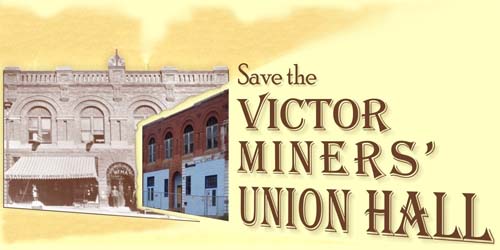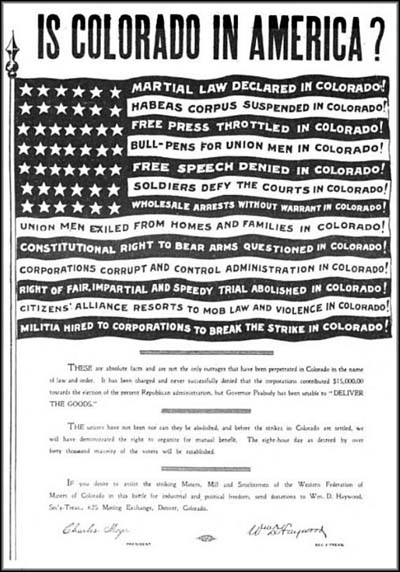 |
Victor
|
The
Pinkerton Labor Spy
by
Morris Friedman

CHAPTER XVI.
A REIGN OF TERROR CONTINUED.
MILITARY NECESSITY.
For charity's sake we will say that perhaps the governor of Colorado considered it his duty to proclaim martial law in San Miguel County when he did, as the county was at that time in the possession of an armed mob which resisted the laws of the State, and by deeds of violence denied the citizens of that county those rights and privileges that are guaranteed to all American citizens.
Since insurrection and rebellion had broken out and threatened life, liberty and property in San Miguel County, the State government was fully warranted in interfering, with armed force if necessary, in order to quell the insurrection, and restore peace.
But the way Governor Peabody interfered in San Miguel County reminds us of the story of a poor foreigner who had just landed in New York. This foreigner, while walking along the streets, happened to run across a gang of loafers who sized him up as a greenhorn, and proceeded to rough-house him. After the fun had lasted about five minutes, a burly policeman rushed up and roughly hustled him off to the station house where the poor, half-dead foreigner was put in a dark cell. The next morning the foreigner was dragged before an unthinking and heartless judge, and charged with causing a serious disturbance on the streets. The judge fined the prisoner ten dollars, and, in lieu of the cash, he was sent to jail for ten days.
Petty persecutions of this kind have occurred in some of our Eastern cities. So far as Colorado is concerned, substitute the word MINER for the word "foreigner"; the phrase PINKERTONS AND MINE OWNERS for the phrase "gang of loafers"; the words GOVERNOR PEABODY for the words "burly policeman"; and the phrase COLORADO SUPREME COURT for the phrase "unthinking and heartless judge," and you have before you in a nutshell a mildly-worded history of the labor troubles in Colorado for the last four years.
Governor Peabody knew well that the mob at Telluride was composed of members of the Mine Owners' Association and members of the Citizens' Alliance. He knew as well as everyone else in the State that Manager Bulkley Wells of the Smuggler Union Mine was the life and soul of this mob, which he personally commanded. Yet Governor Peabody, with the brazen style of the policeman in the anecdote, charged the poor, deported miners with the crime of treason, and in order to prevent these outraged men from returning to their wives and children declared martial law, sent troops down to Telluride at an immense expense to the State, and named Bulkley Wells, the avowed leader of the insurrectionary mob, as the commander of the State militia in this district.
The military had absolutely nothing to do in Telluride, except to watch incoming trains for the purpose of preventing union miners from entering the city. As this kind of work was tedious, the military soon tired of it, and began to look for trouble.
They quickly found what they were looking for in the person of Charles H. Moyer, president of the Western Federation of Miners.
The military discovered that Mr. Moyer was in Ouray, the county seat of Ouray County, where he was going over the situation with the officers of the Ouray Miners' Union, and also with the deported Telluride miners, who had all congregated in this little city.
Now the governor had officially proclaimed that the members of the Western Federation of Miners in San Miguel County had risen in armed rebellion against the State. By virtue of this proclamation, the Federation was practically declared to be an outlaw organization, and its leaders consequently became outlaw chiefs. The militia (or should we say the mine owners?) therefore decided that the insurrection could never be suppressed so long as President Moyer was at liberty, and they concluded to arrest him. The only difficulty lay in the fact that Moyer was in Ouray County, and that county, not being under martial law, could not well be invaded by the military. But little difficulties of this kind could not thwart the desires of the mine owners and militia.
Sheriff Rutan, of San Miguel County, was a willing tool of the Telluride Mine Owners' Association. Papers were sworn out in Telluride charging President Moyer with the crime of "desecrating the American flag," and armed with these papers Sheriff Rutan proceeded to Ouray, where he caused the sheriff of the county to arrest Mr. Moyer on the charge mentioned and lock him up in the county jail. The next day Sheriff Rutan and his prisoner departed for Telluride. Here Mr. Moyer was again locked up in jail pending a hearing.
It is a significant fact that, although President Moyer was arrested in Ouray, amid hundreds of ardent admirers and followers, not a move was made by a single member of the Western Federation of Miners to free their chief by force. The miners felt that the arrest of their president was for some hidden purpose, yet they allowed the law to take its course, ignoring the precedents established by the mine owners and the governor.
The mine owners charged Mr. Moyer with having desecrated the American flag by inscribing sentences in each of the thirteen stripes which were far from complimentary to the State administration, militia and magnates. They also charged that he caused pictures of the flag containing these inscriptions to be scattered broadcast throughout the State.
To a certain extent the charge was well founded, as the Western Federation of Miners had scattered many pictures of the American flag containing the following suggestive statements in the stripes:
(1) Is Colorado in America?
(2) Martial Law declared in Colorado.
(3) Habeas Corpus suppressed in Colorado.
(4) Free Press throttled in Colorado.
(5) Bullpens for union men in Colorado.
(6) Soldiers defy the courts in Colorado.
(7) Free Speech denied in Colorado.
(8) Wholesale arrests without warrant in Colorado.
(9) Union men exiled from homes and families in Colorado.
(10) Constitutional right to bear arms questioned in Colorado.
(11) Corporations corrupt and control administrations in Colorado.
(12) Right of fair, impartial and speedy trial abolished in Colorado.
(13) Citizens' Alliance resorts to mob law and violence in Colorado. Militia hired by corporations to break the strike in Colorado.
There is no doubt on earth but that each and everyone of these thirteen charges is true, and based on facts. The only reason these charges were printed on the stripes of the flag was, because serious accusations of this kind, inscribed on the emblem of liberty, were bound to attract the attention of the public to the unheard-of outrages.
In case of conviction, the maximum punishment for an offense of this kind—defacing the flag—is a fine not exceeding $250, or imprisonment in the county jail for not more than one year, or both.
If the Mine Owners' Association had so much love and reverence for our flag as they professed, it would seem that they should have been anxious to try Mr. Moyer, and, if possible, secure a conviction against him. This was not at all their program.
Mr. Moyer furnished bond, and was released by the civil authorities on March 30th, 1904. However, the instant after he had obtained his liberty in this manner, he was seized by the militia and thrown into the bull pen, where he was kept for many weeks under heavy guard in solitary confinement. The only reason the military would give for the arrest and imprisonment of President Moyer was, "Military Necessity!"
Our flag, which every American citizen would gladly protect, with his fortune and his life, was desecrated and dishonored by the governor of Colorado, his soldiers and the mine owners, by being made to serve as a base decoy for unlawfully depriving an innocent man of his liberty.
Chapter XVII. A Reign Of Terror (Concluded). The Moyer Decision.
